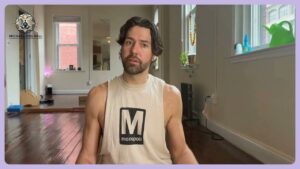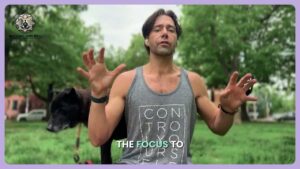Video: Ashtanga Vinyasa Inspired Power Yoga and Breathwork
This is class is 75 minutes. It is a bit of third, second, and first. We begin with a nice alternate nostril pranayama

This is class is 75 minutes. It is a bit of third, second, and first. We begin with a nice alternate nostril pranayama

In this video, Michael Joel Hall discusses the importance of integrating all eight limbs of Ashtanga yoga, rather than focusing solely on the physical practice of asanas. He addresses the potential pitfalls of modern practices, such as the risk of turning yoga into just another workout, the impact of social media on the practice, and the ethical dilemmas faced in a performance-driven culture. Hall advocates for a more comprehensive approach that includes elements like meditation, ethical study, and understanding of foundational texts to truly cultivate a holistic yoga practice.
00:00 Introduction to Modern Ashtanga Yoga
00:08 Criticism and Holistic Approach
00:44 Ethical Dilemmas in Social Media
01:18 Integrating All Eight Limbs
01:31 Conclusion

Title: Harnessing Energy in Ashtanga Yoga: From Grounding to Expansion
—
**Introduction to Energy Management in Ashtanga Yoga**
Hello, hello, hello! Michael Hall here, and today I want to share some insights on managing your energy within the practice of Ashtanga Yoga. This practice transcends the physical; it’s an intricate system working harmoniously with your nervous and energetic systems. The sequence of postures is methodically designed to guide prana—your life force—through the body, balancing effort with ease and integrating activation with relaxation.
—
**Understanding the Primary Series**
Each series in Ashtanga has a deliberate arc, beginning with the Primary Series. This series is all about building stability—it wrings out the body, ensuring your hips and shoulders can twist and your spine can move freely. Beyond its physicality, the Primary Series teaches you how to ground yourself, directing your prana downwards into the earth, known as Ana. This foundational grounding is crucial as it sets the stage for understanding the upward rising energies in later series.
—
**Exploring the Intermediate Series**
Progressing into the Intermediate Series, the practice shifts focus to an upward energy flow. This series activates your internal awareness and internal rotations, requiring greater breath regulation and a sharper mental focus. It’s not just about moving energy up; it’s about mastering the internal aspects of your practice to cultivate an expansive, inward journey.
—
**Advancing to the Advanced Series**
Carrying the principles of the previous series forward, the Advanced Series amplifies both strength and the feeling of lightness and expansion. These poses are wildly intense, demanding refined control to maintain ease amidst the challenge. This series is about finding balance through strength, enhancing your ability to manage energy in demanding postures.
—
**Optimizing Energy in Practice**
Practicing multiple series calls for energy optimization, not merely endurance. Some practitioners fall into the trap of overexerting early on, leaving little energy for later postures. Effective energy management involves using your breath to contain and channel prana wisely, avoiding unnecessary leakage of effort that leads to exhaustion.
—
**Breath Control and Pacing**
Maintaining a steady breath is vital, as erratic breathing can quickly drain your energy. Mastering breath control requires pacing your intensity, resisting the urge to push too early, thereby maintaining balance and ensuring consistent energy throughout your practice.
—
**Self-Regulation and Wise Energy Use**
The structure of Ashtanga Yoga is self-regulating, teaching practitioners to use their energy wisely. The challenge lies not just in your physical capacity to perform each posture, but in learning to harness your energy efficiently so that your practice becomes an energizing, rather than exhausting, experience.
—
**Conclusion: Energizing Your Practice**
Ultimately, the goal of energy management in Ashtanga Yoga is to leave practice feeling energized, not depleted. By understanding the arcs of each series, utilizing breath control, and pacing your intensity, you harness your energy effectively, fortifying the union of body, mind, and spirit.
Embrace the journey of mastering your energy in Ashtanga Yoga, and transform your practice into a source of vitality and inner balance.

In this episode, MJH delves into the methods of qualification for an Ashtanga Yoga teacher, contrasting traditional practices with modern approaches. Hall discusses the historical context of authorization by Patabi the current certification processes. He highlights issues with evaluation models, explaining the benefits of a non-linear understanding of system dynamics over linear assessments. Hall shares personal experiences, including conflicts in teaching methods, and emphasizes the importance of ethical frameworks and personal growth for both teachers and students in Ashtanga Yoga.
00:00 Ashtanga Yoga Assessment Paradigms
00:13 Historical vs. Modern Certification Methods
01:15 Challenges in Modern Certification
02:18 Open Systems, Closed Systems, and Narrow Minds
03:11 Personal Teaching Conflicts and Adaptations
04:13 Linear vs. Non-Linear System Dynamics
05:57 Holistic Criteria for Assessing Teachers
06:26 Balancing Physical and Ethical Development
07:16 Questions for Personal Practice and Teaching
08:35 Conclusion: The Importance of Ethical Teaching

In this video, Michael Joel Hall explores the concept of self-awareness through the practice of yoga. He discusses how physical patterns observed during yoga can mirror deeper mental models affecting our life experiences. Hall encourages understanding not just what we do, but why we do it, by relating the approach to challenging yoga postures with how we handle life’s challenges. He outlines how beliefs manifest in actions and outcomes, and emphasizes the transformative power of awareness. Practical tools such as morning check-ins, pattern journaling, body scans, and mindful transitions are suggested to deepen self-awareness. Hall also highlights the importance of community in accelerating growth and understanding our broader impact on the world. The video invites viewers to start their own journey of self-observation and build a foundation of awareness for personal transformation.
00:00 Introduction to Self-Awareness
00:24 The Mirror of Practice
00:48 Breaking Down Mental Models
01:23 Practical Steps for Self-Awareness
02:37 Tools and Community Support

Michael Joel Hall shares his insights on alignment and form in Ashtanga Yoga, emphasizing the importance of functionality over aesthetics in postures. He discusses how stability, internal awareness, and breath play pivotal roles in developing both strength and flexibility. Hall highlights that true depth in practice arises from understanding the purpose and mechanics of poses rather than merely striving for visually perfect forms.
00:00 Introduction to Alignment in Ashtanga Yoga
00:12 Principles and Practice of Functional Alignment
00:00 Introduction to Alignment in Ashtanga Yoga
00:12 Principles and Practice of Functional Alignment